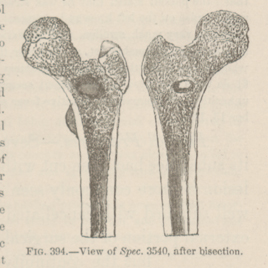Title: Gleason, J.
Source text: The Medical and Surgical History of the War of the Rebellion. (1861-65.), Part 3, Volume 2 (Washington, DC: Government Printing Office, 1883), 720.
Civil War Washington ID: med.d2e25038
TEI/XML: med.d2e25038.xml
CASE 1065.—Private J. Gleason, Co. B, 2d New Hampshire Heavy Artillery, aged 18 years, was accidentally wounded at Washington, May 10, 1864, by a pistol ball, which entered the upper third of the left thigh anteriorly. He was conveyed to Douglas Hospital, where pyæmia subsequently appeared, the first chill occurring on May 26th, and being preceded by marked icterus. The ball could not be discovered. Secondary hæmorrhage from the femoral artery to the amount of fourteen ounces occurred on May 31st, and to the amount of fifteen ounces on the next day, still further adding to the patient's depression. His death occurred on June 1, 1864. At the autopsy the whole body was found to be deeply tinged with bile. No metastatic abscesses were discovered. The knee joint was found to be disorganized, as was also the hip joint on the wounded side, and a large dark-colored cavity existed in the injured thigh, which had been an immense abscess. No secondary deposits were seen in the lungs. On dividing the femur longitudinally, the medullary canal and cancellated portion of the bone were found in a diseased condition. The medulla was softened, of a dark red color, and in the early stage of that change which is seen in well-marked cases of pyæmia after amputation, when this material is found of a dark green color and in a state of advanced decomposition. Before death the patient had wandering delirium for days, profuse perspiration, chills, a rapid feeble pulse, and icteroid hue. The upper third of the injured thigh, longitudinally bisected, and showing an impacted pistol ball, which penetrated the base of the neck and lodged in the cancellated portion, constitutes specimen 3540 of the Surgical Section of the Museum (FIGS. 393, 394), and were contributed, with the history of the case, by Assistant Surgeon W. Thomson, U. S. A.

